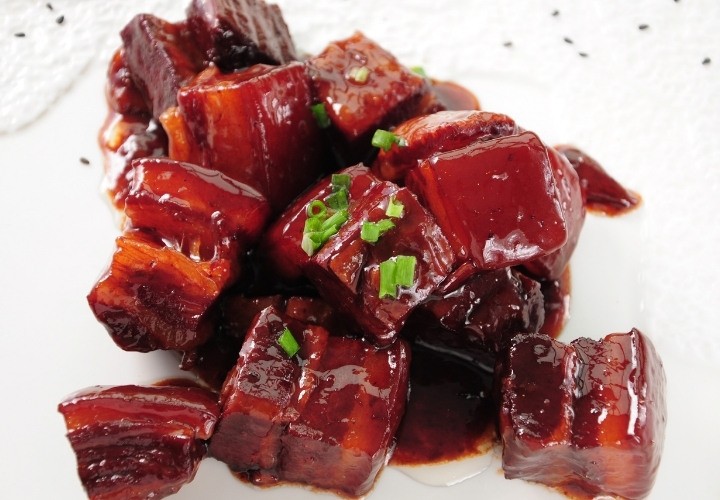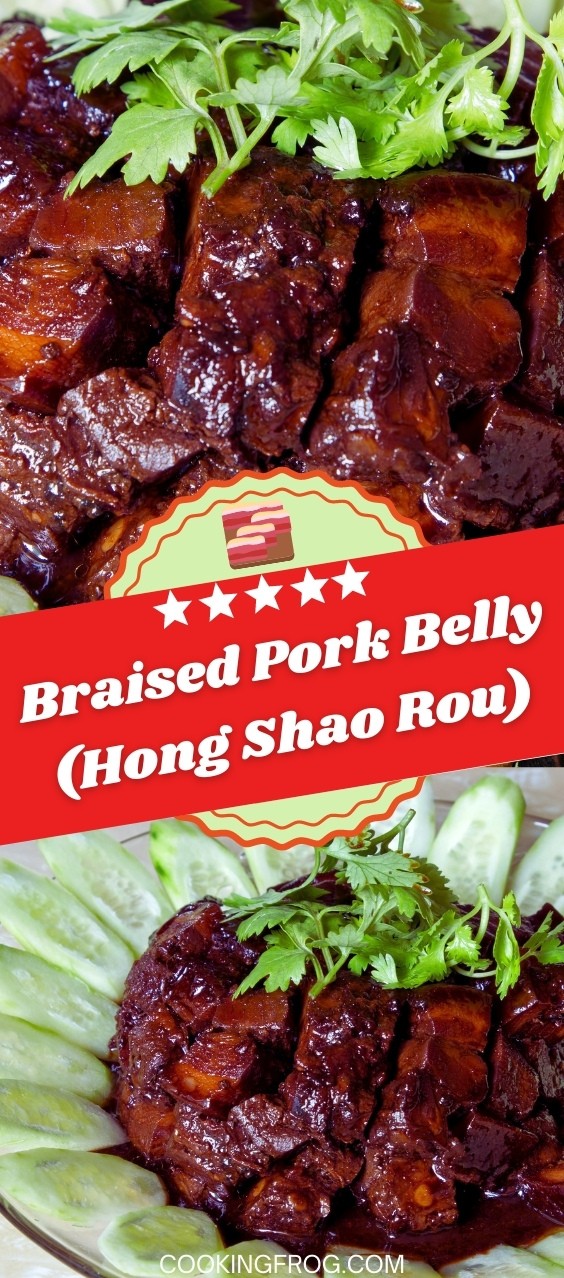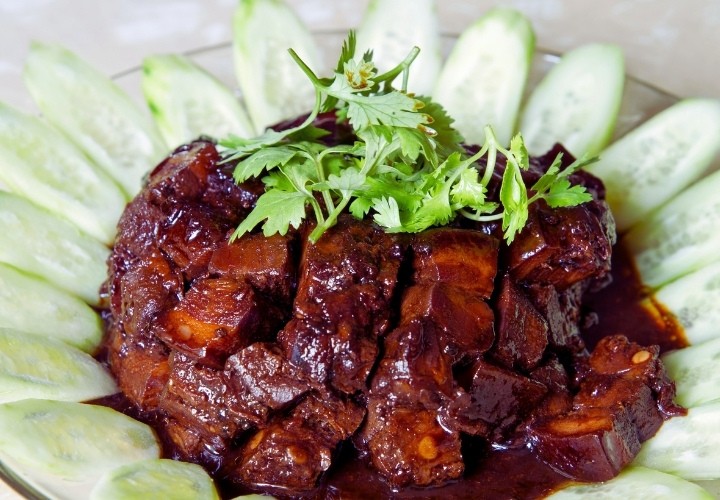Braised pork belly in a syrupy, sweet crimson sauce is known as Hong Shao Rou in China. This dish for pork belly is ideal for a holiday supper!
Holiday feasts are a time for celebration. So there’s no better way to enjoy Christmas vacation than with Hong Shao Rou, a Shanghai-style delicacy of scarlet braised pork belly.
The vivid red color is festive, and the flavor of pork belly is exquisite when seasoned and caramelized with sugar, soy sauce, ginger, and Shaoxing wine!
Red-cooking is used in many of the most famous Chinese pork belly recipes, as well as other pork and duck meals. For most occasions, this Chinese cooking method involves slow-braising pork belly with sugar-based seasonings until it caramelizes and becomes mouthwateringly soft.
What is the meaning of Hong Shao Rou (Red Braised Pork Belly)?
Hong Shao Rou is a braised pork belly dish prepared with soy sauce, sugar, and a variety of aromatics and spices. Hong Shao Rou is a sophisticated meal that incorporates many aromatics to enhance the flavor.
Based on where you travel in China, you’ll find somewhat varied variations of this dish. Some variations use light soy sauce instead of dark soy sauce (yielding a much lighter red hue), while others include vinegar and scallions. Tinker with the ingredients and see what you can come up with!
Two aspects will stay consistent no matter where you go: cooking the meat in “caramel” (warmed brown sugar) before braising and a lengthy braise using a soy sauce-based braising liquid. People may find the initial step of frying the meat in caramel strange, but it is actually a critical step since it seals in the caramel taste.
Due to the extended cooking period, all of the tastes from the braising liquid are soaked into the meat, resulting in a flavor explosion in each mouthful. It will also be very soft as if the meat is dissolving on your tongue.

Hints & Tips for the best Braised Pork Belly
While this recipe is straightforward, there are a couple of things to remember to ensure that you make it correctly the first time!
- Look for a pork belly that has a balanced fat-to-meat ratio. If the meat is too lean, it will not become soft or flavorful. A Chinese grocery shop, such as 99 Ranch, is the best and simplest way to find the correct cut of pork belly. Typically, they will contain components that have already been chopped to the right width.
- To make cutting the meat simpler, parboil it first. This also conveniently leaves us with just enough hot water to braise with. Because you’ll be adding it back to the pork that’s already cooking, it’s best to use hot water for the braise. If you use cold water, the meat may become tough when it comes into touch with it.
- When making caramel, be attentive when dissolving the sugar in the oil. After adding the sugar to the oil, attempt not to stir it until you see a puddle of melted sugar forming. Once part of the sugar has melted, whisk it with a chopstick (or something similar with a low surface area) to speed up the melting process. But be careful, since the caramel will cling to whatever you use to stir it!
- To get the most excellent results, avoid checking on the meat too frequently. We want to keep temperature changes to a minimum when braising, so tossing the meat once every 30 minutes should be enough.
One of my favorite Asian recipes is Chinese braised pork belly (Hong Shao Rou), and I simply can not wait for you all to explore this dish! Let’s get this party started!
Share the image below to your Pinterest board if you like this Braised Pork Belly Recipe!

List of Ingredients
- 1 tbsp Shaoxing wine (or dry sherry)
- 2 tbsp cooking oil
- 2 tbsp light soy sauce
- 1/2 cinnamon stick
- 1/2 inch ginger (sliced thin)
- 4 tbsp dark soy sauce
- 2 cloves garlic (crushed)
- 2-star anise
- 7 tbsp brown sugar
- 3 cups water
- 10 Szechuan peppercorn (optional if you can’t find it at a grocery store)
- 5 pounds thick pork belly (about 1.5 inches wide; skin on)
Directions
- Place the three cups of water in a large saucepan or skillet and bring to a boil over medium-high heat; the level of water must be at least 50 percent the width of the pork belly. Throw in the pork belly and cook for 1 minute on each side, or until the outside is somewhat hard. Set the boiling water aside and transfer the pork belly to a chopping board. Don’t throw it away!
- Pour in the garlic, ginger, star anise, Szechuan peppercorns, and cinnamon stick to the water and heat on low. We must have this water hot since we’ll be returning it directly to the pork, and if it gets cold, the meat will stiffen.
- In an oven or a big saucepan, heat the oil over medium-low heat and chop the pork belly into 1.5-inch chunks on each side. Toss in 3.5 tablespoons of brown sugar. Allow the sugar to rest uninterrupted until it begins to dissolve.
- When the sugar begins to dissolve, stir it with a single chopstick to accelerate the process.
- Once all of the sugar has melted and become a dark caramel hue, add the pork belly. Cook for a few minutes, rotating the chunks halfway through until the caramel has covered practically every surface of each piece. Be careful not to break the parts!
- Cook for a minute after adding the light soy sauce, dark soy sauce, and Shaoxing wine. Then, along with all of the spices and aromatics, pour in the water. Cook the pork belly for 2 hours over medium-low heat, stirring every 30 minutes.
- The pork will be completely tender after 2 hours. Stick a chopstick into the bottom of the meat to see whether it’s cooked. The chopstick must be able to puncture the entire chunk without difficulty. Put the cover back on and continue braising until it achieves your preferred tenderness.
- Remove the cover from the pan and turn the heat up to medium. Mix in the remaining 3.5 teaspoons of sugar—Cook for about 20 minutes or until the sauce has thickened and reduced slightly. To keep the meat from burning, stir it every few minutes. When the sauce is viscous enough to adhere to the meat, you’ll recognize when it’s ready.
- Take the meat from the pan and sprinkle it with some of the remaining sauce. Serve with vegetables and rice of your choice.


